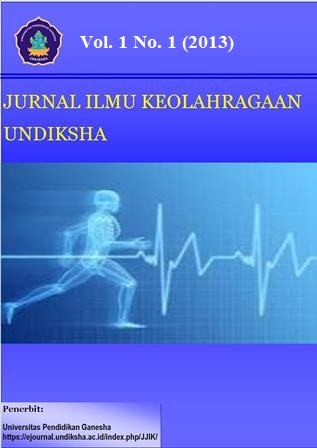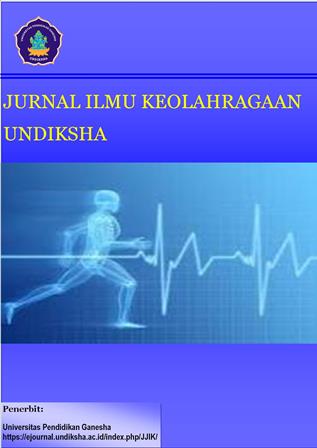PENGARUH PELATIHAN LARI INTERVAL DENGAN RASIO KERJA DAN ISTIRAHAT 1:1 DAN 1:2 TERHADAP DAYA TAHAN KARDIOVASKULER
DOI:
https://doi.org/10.23887/jiku.v1i1.1584Abstract
This study was aimed to identify the effect of interval running training with work ratio and recovery 1:1 and 1:2 toward the cardiovascular endurance. This study was an experimental study which was designed in the randomized pretest-posttest control group design. There were 36 samples for this study which were decided by simple random sampling technique. Cardiovascular endurance measured by MFT test. From the result of independent sample t-test toward the cardiovascular endurance, there was obtained the score of tmeasure was 10.837 and 5.569 with significance 0.000. The significance was < 0.05, meant that there was different effect from each group. Then an anova test was conducted. The result of anova test showed that the variable of cardiovascular endurance between the experimental group and control group obtained Fmeasure of 65.737 and significance 0.000. Because there was a different effect, so the researcher conducted Least Significant Different (LSD) test in order to determine which training have better effect toward the improvement of cardiovascular endurance. Could be concluded that interval running training with work ratio and recovery 1:1 and 1:2 was affecting improvement of the cardiovascular endurance, in which interval running training with work ratio and recovery 1:1 have better effect for the improvement of cardiovascular endurance. From this study it is recommended that this study can be used as reference in conducting the next training and study.Downloads
Published
2013-09-27
How to Cite
Januar Adiputra, A. (2013). PENGARUH PELATIHAN LARI INTERVAL DENGAN RASIO KERJA DAN ISTIRAHAT 1:1 DAN 1:2 TERHADAP DAYA TAHAN KARDIOVASKULER. Jurnal Ilmu Keolahragaan Undiksha, 1(1). https://doi.org/10.23887/jiku.v1i1.1584
Issue
Section
Articles
License
Authors who publish with the Jurnal Ilmu Keolahragaan Undiksha agree to the following terms:- Authors retain copyright and grant the journal the right of first publication with the work simultaneously licensed under a Creative Commons Attribution License (CC BY-SA 4.0) that allows others to share the work with an acknowledgment of the work's authorship and initial publication in this journal
- Authors are able to enter into separate, additional contractual arrangements for the non-exclusive distribution of the journal's published version of the work (e.g., post it to an institutional repository or publish it in a book), with an acknowledgment of its initial publication in this journal.
- Authors are permitted and encouraged to post their work online (e.g., in institutional repositories or on their website) prior to and during the submission process, as it can lead to productive exchanges, as well as earlier and greater citation of published work. (See The Effect of Open Access)










